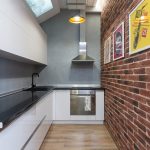Undergoing a kitchen renovation might seem daunting, especially when on a tight budget. However, with careful planning, savvy material selection, and a thoughtful approach to design, you can create a kitchen you’ll love without breaking the bank. The key is to know what elements to consider and how to manage your budget effectively to meet your remodeling goals. Let’s explore how you can accomplish this.
Keeping Project Objectives Clear
Before embarking on your kitchen renovation project, it’s essential to set clear and realistic objectives. Establish what you want to achieve with the remodel, identify your must-haves, and create a wish-list of optional upgrades.
Also to discover : How can technology help in meal planning and grocery shopping for your kitchen?
Having a clear understanding of what you want will guide your design decisions, influence your choice of materials, and ultimately determine where your budget dollars go. Must-haves might include essential appliances or new cabinets, while optional upgrades might encompass luxury items like high-end countertops or the latest kitchen gadgets.
Asking yourself key questions can help you clarify your objectives. Do you need more space? Are your current cabinets falling apart? Do you need new appliances? Is your kitchen design outdated? By identifying what you need, as opposed to what you want, you can allocate your budget more effectively.
Also to read : What are the best features to look for in a modern cooktop?
Designing on a Budget
Design choices can significantly impact the cost of your renovation project. Adopting a minimalist design with clean lines and a neutral color palette is often more affordable than pursuing a high-end, luxury aesthetic.
Choosing open shelving instead of upper cabinets can save money while creating a modern, spacious look. Likewise, opting for a simple paint refresh instead of installing new tiles for a backsplash can dramatically cut costs.
Remember, you can always inject personality and charm into your kitchen through inexpensive decor items, such as rugs, plants, or unique kitchenware. These elements can provide visual interest without requiring a large financial investment.
Selecting the Right Materials
Your choice of materials will significantly influence your renovation costs. Replacing cabinets, for example, can take up to 40% of your kitchen remodel budget.
You don’t have to opt for top-of-the-line materials to get a durable, attractive finish. Consider laminate or thermofoil cabinets instead of solid wood. Or, if your cabinets are structurally sound but outdated, you could simply refinish or paint them for a fresh look.
Countertops also come in a variety of materials with varying costs. While granite and quartz might be desirable, they can be expensive. Materials like laminate or solid surfacing offer a more budget-friendly alternative and come in a range of colors and designs to match your aesthetic.
Planning Your Appliances
Appliances are another factor where costs can quickly add up. Before you fall in love with that high-end range or double-door refrigerator, consider what you actually need from your appliances. Energy-efficient models might cost more initially, but will save you money in the long term.
Also, consider your lifestyle. If you’re a gourmet chef, investing in a quality stove will serve you well. But if you primarily use your microwave, there’s no need to splurge on a professional-grade range.
Managing Renovation Costs
Careful planning and foresight can save you a lot of money. Set a firm budget for your project and stick to it. Be sure to include a contingency fund of about 15-20% for unexpected costs, such as electrical or plumbing issues that might arise during the renovation process.
Shopping sales and discounts can also save you a considerable amount. Look for floor models or slightly dinged appliances. Consider buying materials in bulk or taking advantage of seasonal sales.
Finally, find out what renovation tasks you can do yourself to save on labor costs. Painting cabinets, installing a backsplash, or even demolition can be DIY tasks with a little research and dedication.
In conclusion, a kitchen renovation on a tight budget is achievable with careful planning, smart material choices, and savvy project management. Keep your objectives clear, design wisely, select appropriate materials, plan your appliances, and manage your costs effectively to create a kitchen that combines functionality and style without breaking the bank.
Maximizing Your Kitchen Layout
The layout of your kitchen can significantly influence the functionality and overall appeal of the space. When working on a tight budget, optimizing your existing kitchen layout can be a cost-effective way to improve the space without requiring extensive structural changes.
To start, evaluate your current kitchen layout. Where are the pain points? Are you constantly bumping into the refrigerator when you’re trying to prepare meals? Do you wish you had more counter space near your stove? Addressing these issues can help create a more functional, efficient kitchen without necessarily requiring a complete overhaul.
Consider the classic kitchen work triangle – the configuration of your sink, refrigerator, and stove. Optimizing this arrangement can greatly increase the kitchen’s efficiency and can be achieved without a total remodel.
When it comes to storage, think vertically. Adding extra shelving or installing hooks for hanging pots and pans can provide additional storage without taking up valuable floor space. And don’t forget about the corners! Corner cabinets or lazy Susans can make excellent use of this often wasted space.
For a budget kitchen remodel, it may also be worth considering a partial remodel. Perhaps you only need to update one part of the kitchen, such as the cabinets or backsplash. This approach can save money while still giving your kitchen a fresh new look.
Choosing Budget-Friendly Cabinet Hardware
Cabinet hardware may seem like a small detail, but it can make a big difference in the overall look and feel of your kitchen. Replacing outdated cabinet handles and knobs is an affordable way to update the appearance of your kitchen cabinets.
While high-end cabinet hardware can be costly, many budget-friendly options can still add style to your kitchen. Consider materials like stainless steel or brushed nickel, which are typically less expensive than brass or copper.
You can also save money by buying in bulk. Many home improvement stores offer discounts for buying hardware in larger quantities. Online shopping can also offer a wider selection of styles and finishes, often at lower prices than physical stores.
Finally, remember to measure your existing hardware before purchasing new ones to ensure they will fit correctly. This can prevent the need for any additional drilling or adjustments, saving you both time and money.
Conclusion
Kitchen renovations don’t have to be expensive to be impactful. By clearly defining your project objectives, making smart design choices, selecting budget-friendly materials, and managing your remodel costs effectively, you can achieve a stylish and functional kitchen remodel on a tight budget.
Remember to consider your kitchen layout and make the most of your existing space. Small updates like changing the cabinet hardware can also make a significant difference.
And finally, stay flexible. Renovation projects often come with unexpected surprises, so be prepared to adjust your plans if necessary. With careful planning and a bit of creativity, your dream kitchen might be more affordable than you think.






